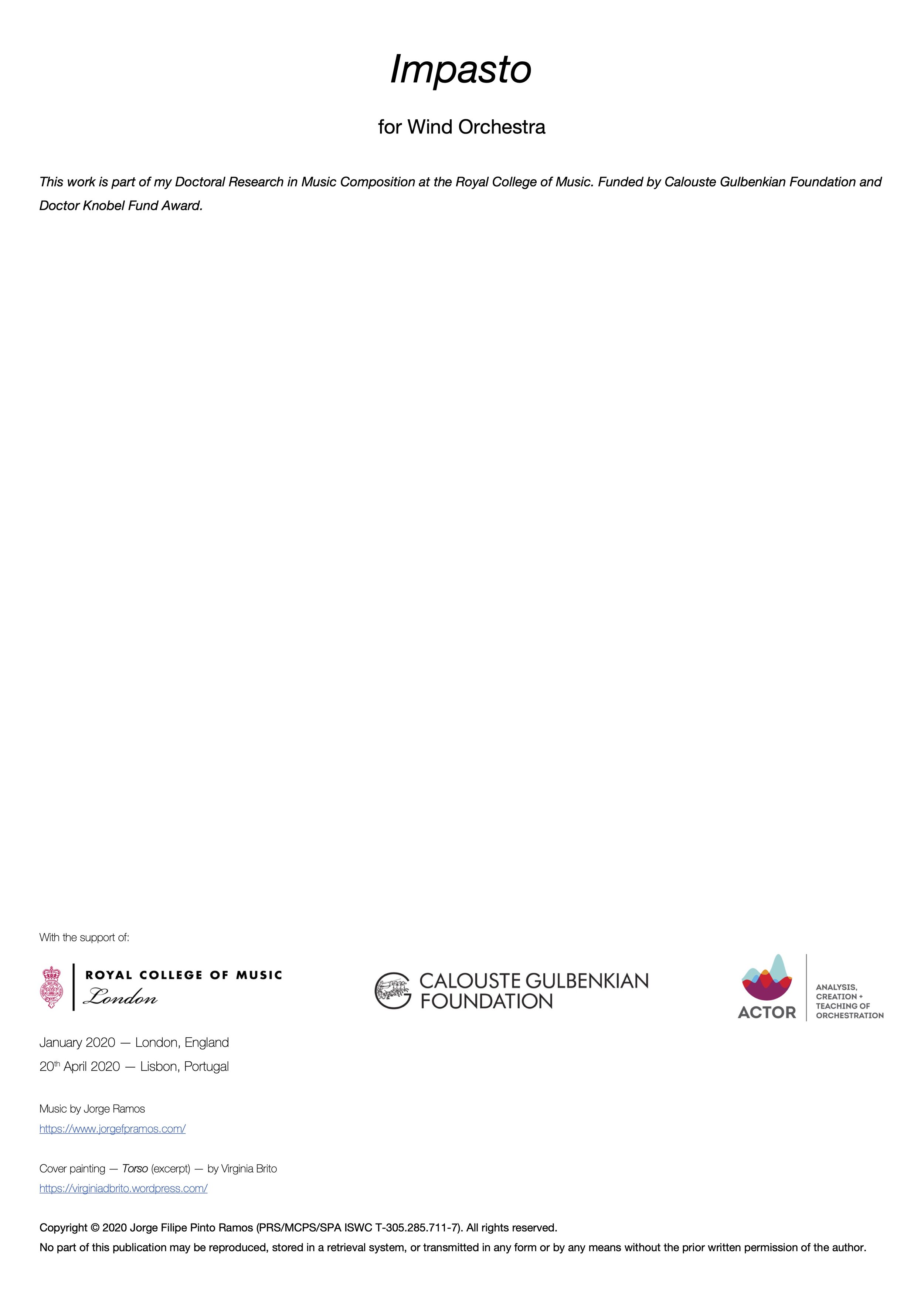 Image 1 of 4
Image 1 of 4

 Image 2 of 4
Image 2 of 4

 Image 3 of 4
Image 3 of 4

 Image 4 of 4
Image 4 of 4





Impasto
Premiere
20/02/2022 - Casa da Música (PT) - Banda Sinfónica Portuguesa and Conductor Osvaldo Ferreira
Awards
1st Prize in the IX Concurso Nacional de Composicão Banda Sinfónica Portuguesa (PT)
Programme notes
Impasto is a painting technique - in which pigment is mixed with oil and beeswax and applied to the canvas in very thick layers, usually thick enough for the brush strokes to be visible. Beeswax is used in place of any other element because of its easy access to artists (cost-effective), as well as its ability to give volume and shape to the colour (i.e. pigment already mixed with oil) without altering its properties, such as contrast and its behaviour when dry.
The impasto technique: makes light reflect and behave distinctly, giving the artist control over where to concentrate the light (and shadow, respectively); can add expressivity and movement to the painting, where the force and speed with which the artist applied the paint now becomes visible; and can transform what was initially a two-dimensional drawing on a canvas into a three-dimensional (almost) sculptural representation of the same painting (because now the painting has texture and shadows).
Having learned about the impasto technique, I tried to relate this painting technique to my knowledge of electronic music, basing myself on the various timbre possibilities obtainable via analogue or digital synthesizers. Having said that, I sought to 'translate' the behaviour of the various components of a synthesizer, which is used to enrich the timbre treatment of the resulting electronic sound, to the acoustic medium, in this case, the Wind Orchestra.
To conclude, both the impasto technique in painting and the synthesizers in music creation share the same goal, to enable a whole new experience - and above all dynamics - as a member of an audience, being possible to experience the same work in different ways depending on where we positioned ourselves.
Written in 2020 as part of my Doctor in Music — Composition at the Royal College of Music, London (PT). With the support of The ACTOR Project (CAN); Calouste Gulbenkian Foundation (PT) & Royal College of Music London (EN).
© PRS/MCPS/SPA ISWC T-305.285.711-7
Are you performing this work? Submit your performance details to be featured in the upcoming events!
Scroll down for recording ↓
Premiere
20/02/2022 - Casa da Música (PT) - Banda Sinfónica Portuguesa and Conductor Osvaldo Ferreira
Awards
1st Prize in the IX Concurso Nacional de Composicão Banda Sinfónica Portuguesa (PT)
Programme notes
Impasto is a painting technique - in which pigment is mixed with oil and beeswax and applied to the canvas in very thick layers, usually thick enough for the brush strokes to be visible. Beeswax is used in place of any other element because of its easy access to artists (cost-effective), as well as its ability to give volume and shape to the colour (i.e. pigment already mixed with oil) without altering its properties, such as contrast and its behaviour when dry.
The impasto technique: makes light reflect and behave distinctly, giving the artist control over where to concentrate the light (and shadow, respectively); can add expressivity and movement to the painting, where the force and speed with which the artist applied the paint now becomes visible; and can transform what was initially a two-dimensional drawing on a canvas into a three-dimensional (almost) sculptural representation of the same painting (because now the painting has texture and shadows).
Having learned about the impasto technique, I tried to relate this painting technique to my knowledge of electronic music, basing myself on the various timbre possibilities obtainable via analogue or digital synthesizers. Having said that, I sought to 'translate' the behaviour of the various components of a synthesizer, which is used to enrich the timbre treatment of the resulting electronic sound, to the acoustic medium, in this case, the Wind Orchestra.
To conclude, both the impasto technique in painting and the synthesizers in music creation share the same goal, to enable a whole new experience - and above all dynamics - as a member of an audience, being possible to experience the same work in different ways depending on where we positioned ourselves.
Written in 2020 as part of my Doctor in Music — Composition at the Royal College of Music, London (PT). With the support of The ACTOR Project (CAN); Calouste Gulbenkian Foundation (PT) & Royal College of Music London (EN).
© PRS/MCPS/SPA ISWC T-305.285.711-7
Are you performing this work? Submit your performance details to be featured in the upcoming events!
Scroll down for recording ↓




